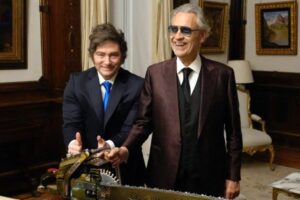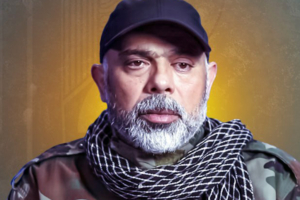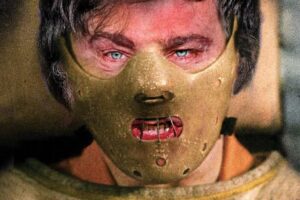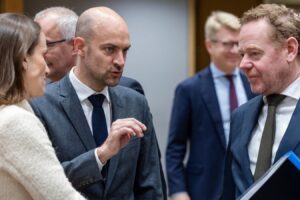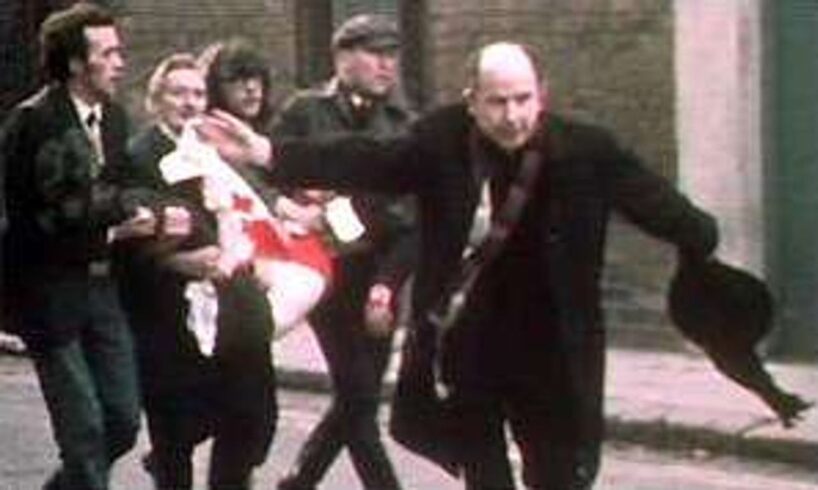
The first evidence presented in the only ever trial of a British soldier for their role in the January 30, 1972 Bloody Sunday massacre in Derry, Northen Ireland described scenes of indiscriminate shootings and execution.
Thirteen civil rights protestors were killed and another 13 wounded, one of them later dying of their injuries. Other demonstrators were hit by shrapnel and rubber bullets, more were beaten, and two were run over by British Army vehicles.
Father Edward Daly, waving a blood-stained white handkerchief as he escorts a mortally-wounded protester to safety during the events of Bloody Sunday (1972) in Derry, Northern Ireland. [Photo: BBC journalist John Bierman]
A former lance corporal of the 1st Battalion of the British Army’s notorious Parachute Regiment, known legally only as Soldier F—although his identity is well known—is accused of the murder of James Wray and William McKinney. He is also accused of the attempted murders of Joseph Friel, Michael Quinn, Joe Mahon, Patrick O’Donnell, and another, unnamed, person.
The case is being held in Belfast Crown Court in a non-jury trial in front of Judge Patrick Lynch, KC. Late September, Lynch ruled that statements made in 1972 by Soldiers G and H can be presented as evidence. Soldier G is now deceased, while H is reportedly unwilling to give evidence.
Joe Mahon was 16 years old on the day he was shot in Glenfada Park North. He told Belfast Crown Court that he and around 40 fellow civil rights protestors had moved to the park, believing it to be safe, after trouble broke out at the large demonstration on the day. Mahon described seeing three or four soldiers enter the park, one of them “had a rifle under his arm hanging down” which he then raised and “started firing from the hip… fan-like, moving from side to side.”
Mahon said he fell down, thinking he had been hit by a rubber bullet. Someone beside him, whom he later found out was William McKinney, was lying on road saying, “I am hit son, I am hit”. A woman told Mahon to “lie still, pretend you are dead”. He watched a soldier walk past them then fire twice into James Wray, who was already lying on the ground.
Joseph Friel, 20 years old in 1972, said the soldier firing from the hip was the “only one firing”. Friel continued, “I was not looking at the soldier’s face, I was looking at his rifle.” Friel was shot in the chest and started coughing up blood.
Malachy Coyle, 15 years old at the time, said CS gas used against the demonstration had made him vomit and unable to breathe. Someone pulled him into a backyard. He looked through the slats of a fence at three bodies on the ground. One man moved his head and looked up to say, “I can’t move my legs.” Coyle told him “don’t move, pretend you are dead”. Coyle was then shot. Another soldier, not wearing a helmet and looking “angry and unstable”, opened fire towards a young man hiding behind nearby flats. Coyle said he heard this soldier tell a group of people, “I’m going to shoot you, you Irish bastards.”
Michael Quinn, 17 years old at the time of the shootings, heard gunfire and saw soldiers jumping out of a British Army Saracen armoured personnel carrier. One started swinging the butt of his rifle “like a club”. A man was shot. Quinn told the court, “I could see he was shot… I heard him call out, scream. I looked at him and saw a ring of blood emerging on his leg and he was collapsing to the ground.” Quinn himself was shot in face, a bullet exiting through his nose. “I felt myself being struck by the bullet… I could see the flesh and blood breaking away from my face.”
Bloody Sunday is one of British imperialism’s most infamous colonial crimes. It took place three years into Operation Banner under which the Labour government of Harold Wilson deployed the British Army to prevent the collapse of the hated Ulster Unionist administration, in the face of a mass civil rights movement demanding equal rights for Catholics.
The movement in Northern Ireland was part of a worldwide eruption of class struggle between 1968 and ‘75. In 1971, Wilson’s Conservative successor, Edward Heath, introduced mass arrests and internment without trial of suspected Irish republicans. Hundreds were seized and tortured, their homes smashed up.
US President Richard Nixon (right) and UK Prime Minister Edward Heath shake hands upon Heath’s Arrival at the White House [Photo: Series: Nixon White House Photographs, 1/20/1969 – 8/9/1974 Collection: White House Photo Office Collection (Nixon Administration), 1/20/1969 – 8/9/197]
By the time of the January 30, 1972 march, 22,000 troops, including the Parachute Regiment, were active in Northern Ireland. Between 10,000 and 15,000 people intended to protest against interment. The day, billed as a family event, was due to conclude with speeches. Rather than accept a peaceful protest, the Heath government authorised an attack on the march. The meeting of the Joint Security Committee in Belfast proves the government sought to “prepare public opinion… for violent scenes on TV” and concluded “the operation might well develop into rioting and even a shooting war”.
When the scale of British Army violence resulted in even the Irish government of Jack Lynch protesting, Heath blamed the marchers themselves, organised in the Northern Ireland Civil Rights Association. Heath also blamed the Provisional Irish Republican Army who played no role on the day at all.
Ever since, the British government has sought to cover up, lie, obfuscate and delay any meaningful investigation into what took place, obstructing the push for prosecutions. The Widgery Inquiry, set up in 1973, became almost a synonym for whitewash.
A more thorough inquiry under Lord Saville—set up by the Blair Labour government as part of the 1998 Good Friday Agreement—sustained the whitewash in a more complex form. Saville took 10 years to conclude in 2010, despite a vast amount of evidence pointing to the responsibility of the Heath government and leading army officers, that the massacre was somehow the result of soldiers on the ground “losing their self-control.” Saville identified Soldier F as having shot three people, and possibly another two.
Finally in 2019, Northern Ireland’s prosecution service concluded there was enough evidence to charge Soldier F, one of 21 members of the Parachute Regiment who fired their weapons on the day. Relatives and supporters of those killed and wounded had been expecting another four soldiers to be charged.
The case was halted in 2021 over the admissibility of written evidence taken by the Royal Military Police in 1972 and oral evidence given to the Widgery Inquiry, and not revived for another two years. In 2024, cases were dropped against 15 former soldiers, including Soldier F, over allegations of perjury, despite Saville having criticised their false accounts.
Soldier F’s long delayed trial, which opened on September 15 and is expected to last several weeks, is only one of a stream of contested cases emerging from the decades long “dirty war”.
One of the most dangerous to the authorities is the murder of Sean Brown. Brown, a father of six, was killed after closing up the Wolfe Tone Gaelic Athletic Association club in Bellaghy, on May 12, 1997. Shortly after 11.30 p.m., Brown, a popular local figure with no political involvement, was abducted and bundled into the back of his own car. The car, in convoy with two others, was driven past the local Royal Ulster Constabulary station to a secluded lane where Brown was shot six times.
Brown is known to have been killed by the Loyalist Volunteer Force, who opposed the Good Friday Agreement which ended the decades of “Troubles” in Northern Ireland.
Last year, it emerged at an inquest that as many as 25 people, including a number of state agents, were known to have been involved in the killing. The inquest was halted by the coroner as material was being withheld by the British government on national security grounds.
The Northern Ireland High Court ruled last December that Northern Ireland Secretary Hilary Benn must set up a public inquiry. In April, Benn was informed he had to do this in four weeks. The Labour government responded by taking a case to the Supreme Court—hiding behind the legal pretext of seeking to clarify a constitutional principle of whether the government or the judiciary have the right to establish public inquiries.
Supporters and friends of Sean Brown and his family have persistently called for a public inquiry, demonstrating outside the headquarters of MI5 in central London this June. Irish Tánaiste (deputy premier) Simon Harris has felt obliged to back these demands, but nothing has been changed in Brown’s case by the recent agreement between the British and Irish governments on how to proceed with “legacy” cases.
Join the fight for socialism!
Fill out the form to be contacted by someone from the WSWS in your area about getting involved.
